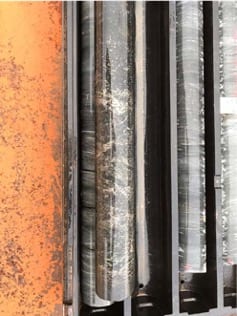Maiden Drilling Campaign Shows Potential
Western Australian focussed mineral explorer Strickland Metals Limited (ASX:STK) has discovered copper mineralisation discovered in association with an extensive sulphide rich system at its Doolgunna Project.
The second diamond hole at Doolgunna intersected interbedded black shales and siltstones from 140 to 408m with increasing pyrite/pyrrhotite at depth, including trace chalcopyrite from 380m.
The second Diamond drill hole DGDD002 has now been completed to a depth of 555.3 metres. The drilling programme has been curtailed for the year to allow time to demobilise the field camp before Christmas.
Executive Chairman, Andy Viner, said a thorough review of all data will be completed in early January 2021, including assays from samples yet to be submitted, prior to further field exploration being undertaken.
The second diamond drill hole, designed to test below the centre of an outcropping gossan at a depth of around 200 to 300m depth, was extended to become a stratigraphic hole to ensure the entire anomalous zone was definitely intersected through the package of interbedded shales and siltstones into a basal sandstone unit.
As with the first hole, a thick package of interbedded siltstones and black shales was intersected through the upper part of the hole, with beds of graphitic shales from 0.2 to 6 metres width with disseminated pyrite and pyrrhotite, becoming more common towards the base.
Mr Viner said the company had noted that surface lag soil sampling had indicated a stronger copper anomaly at the base of the shale rich sequence and hence the second hole was re-designed to penetrate through the shale/siltstone sequence and into the basal sandstone units to investigate the interpreted mineralised zone.
Preliminary geological logging of the drill core noted that a very strong chlorite-biotite-carbonate altered unit was intersected, some five metres below the last black shale unit at 413m depth, below which a 0.5 metre wide semi-massive pyrrhotite mineralised zone comprising approximately 5% chalcopyrite (confirmed with pXRF) is present.
The sulphide zone is parallel to bedding and confirms that a copper target is present, as interpreted from surface geochemistry.
Below this mineralised zone siltstones predominate with variable degrees of alteration, including zones of strong magnetite, above two narrow basalt units intersected at 488 and 492m.
“The presence of copper bearing sulphides in a previously thought barren sequence within the Bryah Basin, vindicates the Board’s decision to secure an Option to acquire exploration licence E52/3495 earlier in the year,” Mr Viner said.
“The company is looking forward to accelerating exploration activities in early 2021 with a view to further proving the base metal potential within the Licence.”












